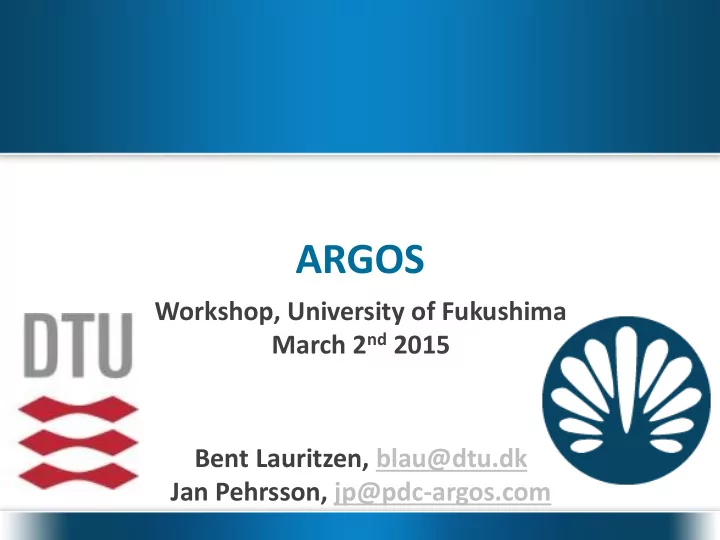

ARGOS Workshop, University of Fukushima March 2 nd 2015 Bent Lauritzen, blau@dtu.dk Jan Pehrsson, jp@pdc-argos.com
What is ARGOS • Decision Support System (DSS) for Nuclear Health and Safety – off-site • Dispersion prognoses, measurement data and dose calculation (short and long term) • For exercises, dimensioning – and accidents Model calculation of 131 I deposition performed by NRPA in ARGOS DSS during the Fukushima accident
Where does ARGOS come from? A ccident R eporting G uidance and O perational Analysis for operational use S upport • Monitoring • Measurements • Modeling – Urban/Meso/Long Dispersion calculation – External Dose – Food Dose
ARGOS history 1. The first primitive version of ARGOS was presented in 1986 (Chernobyl) 2. A complete rewriting into Windows NT (ß) was done in 1993 (Nuclear) 3. In 2001 DEMA and Prolog Development Centre established a consortium of users now covering: Australia, Brazil, Bosnia-Herzegovina, Canada, Denmark, Estonia, Ireland, Lithuania, FYR Macedonia, Montenegro, Norway, Poland, Serbia, Sweden 4. ARGOS users include: VDD, Latvia. DSO, Singapore. Tokyo University. North West university, ZA 5. In 2005 Chemical scenarios were included 6. In 2009 full CBRN functionality implemented
ARGOS Goals • Get an overview of the incident. • Create a prognosis of how the incident will evolve. • Calculate consequences of the incident. • Handle information to decision makers. • Support decision on appropriate countermeasures. • Handle information/decisions to the public. ARGOS collects data in order to provide INFORMATION
Cooperation during Fukushima incident • DTU provided high resolution land-use and orography within 36 hours • ARPANSA provided worldwide NWP within 24 hours • RPB, NRPA, SSM and DEMA all provided long range dispersion calculations within 36 hours • Through out the accident ARGOS users continued to share data, information and results • Developers provided improved interface to NOMADS NWP within 48 hours
RIMPUFF – Dispersion calculation • Developed by RISØ-DTU • Range: 0 to “some hundred km’s” • Puff-based model • Driven by – NWP – Met-Towers – Manual Met input – Combinations of the above • Handles Wet deposition – NWP, Radar, Manual input
Operational model description Items ARGOS Code name ARGOS (RIMPUFF for meso scale dispersion calculation) Development organization PDC-ARGOS ApS – Danish Technical University Operational organizations DEMA-DK 1992, ERPC-EE 1995, EPA-LT 1995, PAA-PL 1997, EPA-IE 2001, NRPA- NO 2001, RPB-CA 2002, SSM-SE 2003, ARPANSA-AU 2007, CNEN-BR 2007, MUP-ME 2008, MST-BA 2010, MSB-MK 2011, MUP-RS 2012 Air flow model Given by NWP-model Gas dispersion model Lagrangian puff Dry deposition model Resistance analog model - FDM Wet deposition model Parameterizations washout rate Precipitation data Observed data (radar) and/or calculated data from NWP Calculation spatial domain Rectangle (Min 1x1 km. Max 2560x2560 km) Gridsize: Min. 50 m. Max 5 km. Calculation time step Min. 1 min. Max. 10 h Output data Total Effective Dose, Inhalation Dose, Thyroid Organ Dose, External Gamma Dose from Plume and/or Ground, Time of Arrival, Total Gamma Dose Rate from Plume and Ground, Air Concentration Time integrated, Air Concentration Instantaneous, Deposition on Ground Terrain effect Imported terrain grid and landuse Source term estimation Import from external model or look-up-table
Long Range dispersion • Interface to external models • ARGOS calculates dose assessments
Atmospheric dispersion modelling: uncertainty and how to show it • Reference Level, e.g.: ∆𝐹 𝐽𝑀 = 100 mSv 𝑄 ∆𝐹 > ∆𝐹 𝐽𝑀 = 10% < ∆𝐹 > = 1 𝑂 ∆𝐹 = ∆𝐹 𝐽𝑀
Scenario 1: 2011-03-14 0 UTC NWP Total deposition 10 th percentile 50 th percentile 90 th percentile Cs-134 I-131
Scenario 1: 2011-03-14 0 UTC NWP Total deposition 𝑄(𝑑 > 10 4 Bq/m 2 ) 𝑄(𝑑 > 10 3 Bq/m 2 ) 𝑄(𝑑 > 10 2 Bq/m 2 ) Cs-134 I-131
Interface for manual Measurements Monitoring points
Interface for Monitoring Stations
Import/Export of monitoring data Here AGS from NNSA showing ɣ -dose rate measured April 28th 2011 as an example
Long term Dose Assessment • Agricultural areas • AGRICP-model • Countermeasures – food act. / ingestion dose • Inhabited areas • ERMIN-model • Initial dose on to surfaces – countermeasures • Both models include Countermeasures • AGRICP: reducing ingestion dose • ERMIN: reducing external β and γ exposure from deposited material and internal dose from resuspended material • Both models can run using • Dispersion calculation results • Measurements
Recommend
More recommend